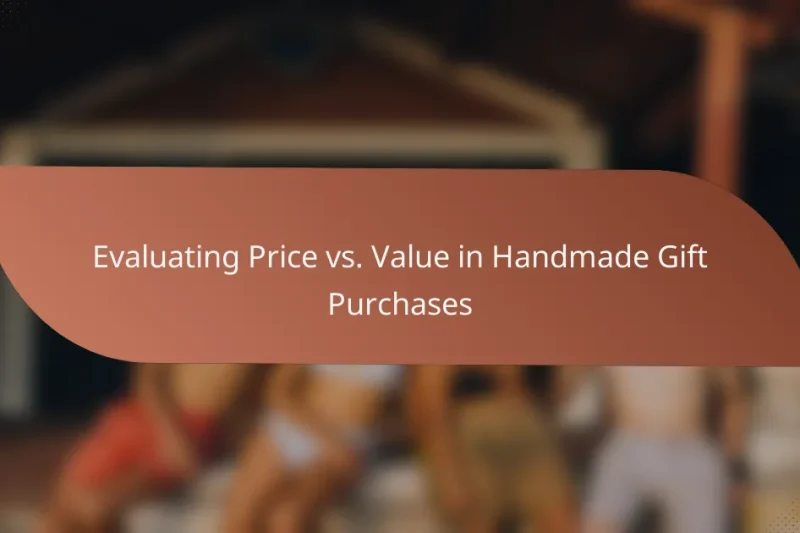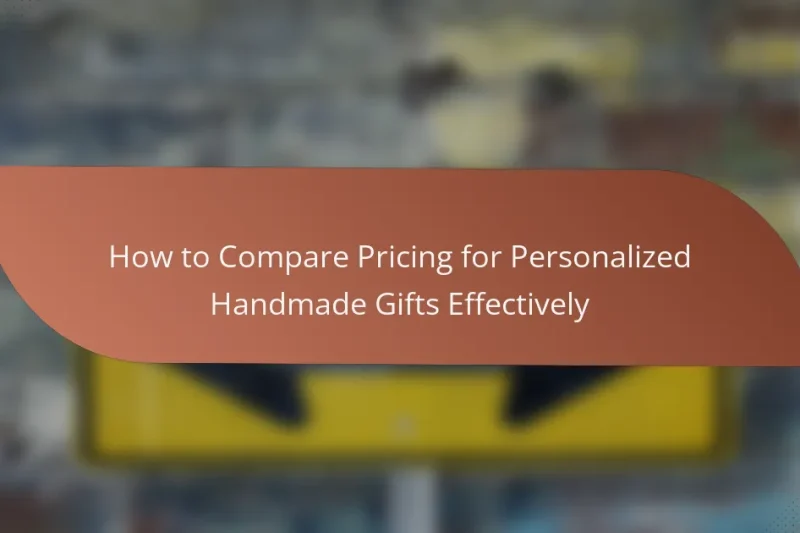When purchasing handmade gifts, it’s essential to evaluate the balance between price and value. Factors such … Evaluating Price vs. Value in Handmade Gift PurchasesRead more
Personalized Handmade Gift Shops: Pricing Strategies for Handmade Gifts
Pricing personalized handmade gifts requires a careful balance of material costs, labor, and market demand to reflect their true value. By understanding these factors, artisans can develop effective pricing strategies that appeal to their target audience while ensuring profitability. This approach not only highlights the craftsmanship involved but also positions the products competitively in the market.
How to Compare Pricing for Personalized Handmade Gifts Effectively
Comparing pricing for personalized handmade gifts requires careful research and consideration of various factors. By exploring … How to Compare Pricing for Personalized Handmade Gifts EffectivelyRead more
Understanding Pricing Models in the Handmade Gift Market
In the handmade gift market, understanding pricing models is essential for artisans to effectively position their … Understanding Pricing Models in the Handmade Gift MarketRead more
How to Budget for Personalized Gifts: A Comprehensive Guide
Budgeting for personalized gifts requires careful planning to ensure you can give meaningful presents without straining … How to Budget for Personalized Gifts: A Comprehensive GuideRead more
The Impact of Quality on Pricing in Personalized Gifts
The quality of personalized gifts plays a crucial role in determining their pricing, as superior materials … The Impact of Quality on Pricing in Personalized GiftsRead more
The Role of Discounts and Promotions in Handmade Gift Pricing
Discounts and promotions play a crucial role in shaping the pricing strategy for handmade gifts, as … The Role of Discounts and Promotions in Handmade Gift PricingRead more
Comparing Pricing Strategies of Different Personalized Gift Shops
In the competitive landscape of personalized gift shops in the US, diverse pricing strategies play a … Comparing Pricing Strategies of Different Personalized Gift ShopsRead more
How to price personalized handmade gifts effectively
To price personalized handmade gifts effectively, consider the costs of materials, labor, and overhead while also reflecting the perceived value to customers. A balanced approach ensures profitability while appealing to buyers who appreciate craftsmanship.
Cost-plus pricing strategy
The cost-plus pricing strategy involves calculating the total cost of creating a handmade gift and adding a markup percentage to determine the selling price. This method ensures that all expenses are covered and a profit margin is achieved. For example, if the total cost of materials and labor is $30, adding a 50% markup would set the price at $45.
While straightforward, this approach may not always capture the true value of unique handmade items. Consider adjusting the markup based on demand and customer willingness to pay.
Value-based pricing approach
The value-based pricing approach focuses on the perceived value of the handmade gift to the customer rather than just the cost of production. This method requires understanding what customers are willing to pay based on the emotional connection and uniqueness of the item. For instance, a personalized gift that holds sentimental value may command a higher price than its material costs suggest.
To implement this strategy, gather customer feedback and analyze similar products in the market. This insight can help set prices that reflect the true worth of your creations.
Competitive pricing analysis
Competitive pricing analysis involves researching the prices of similar handmade gifts offered by other sellers. This strategy helps you position your products within the market effectively. For example, if similar personalized gifts are priced between $40 and $60, you might choose to price yours within that range based on your unique selling points.
Be cautious not to undervalue your work in an effort to compete. Instead, highlight distinctive features or superior craftsmanship to justify your pricing. Regularly review competitors’ prices to stay informed and adjust your strategy as needed.
What factors influence pricing for handmade gifts in the US?
Pricing for handmade gifts in the US is influenced by several key factors, including material costs, labor and time investment, and market demand. Understanding these elements can help artisans set competitive yet fair prices for their unique creations.
Material costs
Material costs are a primary factor in determining the price of handmade gifts. Artisans should account for the price of raw materials, which can vary widely based on quality and source. For example, using organic or locally sourced materials may increase costs but can also justify higher pricing.
It’s essential to keep track of all material expenses, including shipping and taxes, to ensure accurate pricing. A good practice is to calculate the total material cost per item and add a markup to cover overhead and profit margins.
Labor and time investment
The time and effort invested in creating handmade gifts significantly impact pricing. Artisans should consider the hours spent on production, from design to final touches. For instance, a complex item that takes several hours to create should be priced higher than a simpler piece.
When setting prices, artisans can use an hourly wage that reflects their skill level and experience. This approach ensures that the time spent crafting the gift is adequately compensated and helps to establish a sustainable business model.
Market demand
Market demand plays a crucial role in pricing handmade gifts. If a particular style or trend is popular, artisans can often charge more due to increased interest. Researching current market trends and understanding customer preferences can help artisans position their products effectively.
Additionally, analyzing competitors’ pricing can provide insights into what customers are willing to pay. Artisans should be mindful of their unique selling points and adjust prices accordingly to reflect the value they offer in a competitive market.
How to determine the right pricing strategy for your shop
Determining the right pricing strategy for your handmade gift shop involves understanding your costs, target audience, and market conditions. A well-defined strategy helps ensure profitability while remaining attractive to customers.
Assessing target audience
Understanding your target audience is crucial for setting effective prices. Consider demographics such as age, income level, and buying habits. For instance, if your audience consists of young professionals, they may be willing to pay more for unique, high-quality items.
Engage with your audience through surveys or social media to gather insights on their spending preferences. This feedback can guide your pricing decisions and help you tailor your offerings to meet their expectations.
Evaluating competitors
Analyzing your competitors’ pricing can provide valuable context for your own strategy. Look at similar handmade gift shops in your area or online and note their price ranges. This comparison can help you position your products competitively.
Consider factors such as product quality, brand reputation, and customer service when evaluating competitors. If your products offer unique features or superior craftsmanship, you may justify higher prices compared to others.
Testing price points
Testing different price points can help you identify the optimal price for your handmade gifts. Start by setting a baseline price based on your costs and competitor analysis, then experiment with slight adjustments. Monitor sales performance and customer feedback closely.
Utilize strategies like limited-time promotions or bundling products to gauge customer response to different pricing. This approach can reveal how sensitive your audience is to price changes and help you refine your pricing strategy over time.
What are common pricing mistakes in e-commerce for handmade gifts?
Common pricing mistakes in e-commerce for handmade gifts can significantly impact profitability. Many sellers overlook crucial factors such as product value, costs, and market trends, leading to pricing that fails to reflect the true worth of their creations.
Undervaluing products
Undervaluing products is a frequent error among artisans. Many creators set prices based on materials alone, neglecting the time and skill involved in crafting their items. This can result in prices that do not adequately compensate for labor, leading to unsustainable business practices.
To avoid this pitfall, consider calculating an hourly wage for your work and adding it to material costs. For example, if materials cost $20 and you value your time at $15 per hour for a 2-hour project, the minimum price should be $50.
Ignoring overhead costs
Ignoring overhead costs is another common mistake that can erode profits. Overhead includes expenses like shipping, website maintenance, and marketing, which are essential for running an e-commerce business but often go unaccounted for in pricing.
To ensure all costs are covered, create a comprehensive list of your monthly expenses and divide them by the number of products you expect to sell. This will give you a clearer picture of how much to add to each item’s price to maintain profitability.
Not adjusting for seasonal trends
Failing to adjust prices for seasonal trends can lead to missed opportunities. Handmade gifts often see fluctuations in demand during holidays and special occasions, which should be reflected in pricing strategies.
Consider raising prices during peak seasons like Christmas or Valentine’s Day when demand is higher. Conversely, during slower months, offering discounts or promotions can help maintain sales volume. Monitoring market trends can help you make informed adjustments to your pricing strategy throughout the year.
How to implement discounts and promotions effectively
Implementing discounts and promotions effectively involves strategic planning to attract customers while maintaining profitability. Consider your target audience and the types of promotions that resonate with them, such as seasonal discounts or loyalty rewards.
Seasonal sales strategies
Seasonal sales strategies leverage holidays and special occasions to boost sales. For instance, offering discounts during the winter holidays or Valentine’s Day can attract more customers looking for unique gifts. Consider creating themed products or limited-time offers to enhance appeal.
Timing is crucial; start promotions a few weeks before the holiday to capture early shoppers. A discount range of 10-30% is common, but ensure it aligns with your profit margins.
Bundling products for value
Bundling products involves grouping several items together at a discounted price, providing customers with perceived value. For example, if you sell handmade candles, consider bundling them with decorative holders or gift sets. This not only increases the average transaction value but also encourages customers to purchase more.
When creating bundles, ensure the combined price reflects a genuine discount, typically around 15-25% off the individual prices. Highlight the savings in your marketing to entice buyers.
Loyalty programs for repeat customers
Loyalty programs reward customers for their repeat business, fostering long-term relationships. Implement a points system where customers earn points for every purchase, which can be redeemed for discounts or exclusive products. This encourages them to return for future purchases.
Consider offering a sign-up bonus or special discounts for members to incentivize enrollment. A well-structured loyalty program can increase customer retention by 20-30%, making it a valuable strategy for handmade gift shops.
What are the best platforms for selling handmade gifts online?
The best platforms for selling handmade gifts online include Etsy, Amazon Handmade, and Shopify. Each platform offers unique features tailored to artisans and crafters, making it easier to reach potential customers.
Etsy
Etsy is a leading marketplace specifically designed for handmade and vintage items. It provides an easy-to-use interface and a large audience interested in unique products. Sellers should consider listing fees and transaction costs, which can vary but typically range from 5% to 6.5% of the sale price.
Amazon Handmade
Amazon Handmade allows artisans to sell their products on one of the largest e-commerce platforms. This option offers access to a vast customer base but comes with a monthly subscription fee and higher selling fees compared to Etsy. Sellers should weigh the benefits of increased visibility against the costs involved.
Shopify
Shopify is a versatile platform that enables sellers to create their own online stores. This option provides complete control over branding and customer experience. However, it requires a monthly subscription fee and additional costs for payment processing, which can be around 2.9% plus a fixed fee per transaction.






